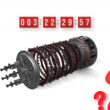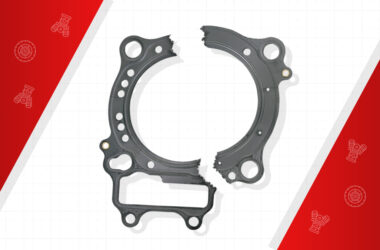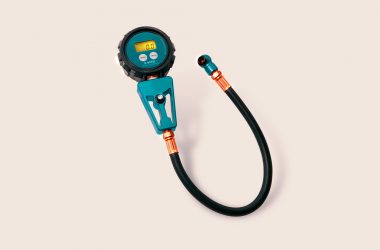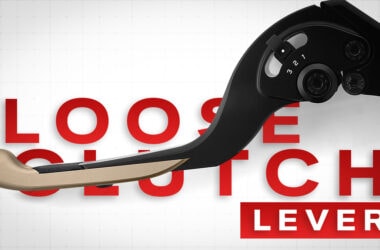Table of Contents Show
When lubing your motorcycle’s chain, a lot of factors come into play such as when to do it, how often, how to do it, and much more. But lubing your chain at the right time or intervals will save you a lot of trouble. So how often should you lube your motorcycle chain?
A motorcycle chain should be lubed every 300 miles/500 kilometers if it’s ridden frequently in minimal dusty conditions or moderate pollution ( i.e Daily commute ). The chain lubing interval changes to every 200 miles/400 kilometers in dusty/rainy conditions as it’s prone to get dirty on a frequent basis.
Following a proper chain maintenance routine will not only prolong your motorcycle’s chain lifespan but will also eliminate damage to adjacent parts around it. Chain lube intervals can vary depending on the number of miles/kilometers a motorcycle is driven, the way it is driven, and the surroundings.
In this article, you will learn the in’s and out’s of why, when, and how to take care of your motorcycle’s chain so you don’t have to face any kind of problems.
How To Tell If A Motorcycle Chain Needs Lube
Before lubing chain inspection is necessary, if the chain looks dry or is making noise while driving it is a sign that you should lube your motorcycle chain regardless of the miles/kilometer driven.
A motorcycle needs lube when the chain is dry or sounds clunky. When a rider experiences hard gear shifts, unexpected jerk while launching a bike, rough downshifts, low vehicle efficiency, and lower mileage. One can inspect the chain visually and by touching it. It should be sticky enough to maintain a smooth motion between chain and sprockets.
If you accelerate your bike way too hard and your rough on downshifts then the heat will be induced in chain and sprockets resulting in more consumptions of chain lube. It’s because of the simple thermodynamics, if the acceleration is more the chain and sprockets rotate at a much higher speed resulting in more friction.
This higher amount of friction and heat production will cause the chain to consume lube more than required to keep it functioning at optimum condition.
On the other hand, if you are a gentle rider who does not rip the accelerator every time you ride then the bike’s chain lube interval would be less often. ( ex. Around 300 miles / 480 Kilometers To 600 miles/ 960 kilometers )
Riding your motorcycle in the rainy season demands frequent chain lubing because the rainwater sweeps all the lube from the chain making it dry. As you know by now dry chains are more prone to rust, if the chain gets dirty in case you are off-roading then you should clean the chain and lube it after your every ride, as the dirt particles and grimes are lethal for chain and the sprockets.
Whenever a rider experience rash driving, clunky sound, hard gearshifts it’s a sign that the bike chain needs lubrication. A motorcycle with an IC engine is engaged in motion, so there are lots of moving parts that need lubrication. As the chain and sprockets are also moving parts that are exposed to the atmosphere, they should be prioritized and lubricated routinely.
Avoiding the routine chain lubing process will give rise to the formation of rust as there is no protective layer between the chain and the surroundings. This will result in high maintenance costs, as the chain and sprockets both will need replacing as both of them will rust eventually. There’s a saying “A stitch in time saves nine”.
Not lubing your chain on time will also result in lesser fuel efficiency, poor mileage, poor motorcycle performance.
How Should You Clean Your Motorcycle Chain
It’s not hard as you think it is. Cleaning your motorcycle chain is plain and simple, but there’s a specific way to do it. You don’t have to be too rough or gentle while brushing your chain to get the dirt and gunk off it. So how should you clean your motorcycle chain, is there a certain to do it?
Here’s a step by step process of cleaning your motorcycles chain
- Place your motorcycle on the center stand and try keeping your bike in a neutral position.
- Start applying Chain cleaner or kerosene all over the chain as well as on the sprocket.
- Turn the wheel gently and slowly so all the chain cleaner can go through and around the chain sweeping the dirt from it.
- Use a three-sided chain cleaning brush stick and start deep cleaning all four sides of the chain while rotating your wheel slowly.
- Once you clean the chain leave it for a while to let it dry.
- Take it for a short ride at moderate to low speed just to get the chain warm enough.
- Apply chain lube evenly, viola! Your ride is ready for a ride.
CAUTION: Don't put your bike in gear while cleaning and lubing the motorcycle, it might lead to serious injury, or the bristle of the brush might get stuck between the moving parts.
You can also use a motorcycle cruise control throttle lock while your bike is in gear to control and maintain a specific speed. But we recommend using your hands to roll the tire as you will have more control over the process.
Placing your motorcycle on a paddock stand or G-Roller will make it easier for you to roll your motorcycle’s tire easily and effectively.
Cover all the parts of the chain and make sure that you don’t over-lube it. Over lubing will attract dirt/grime and will make a mess on the rim and under the tail just make sure that you wipe off excess chain lube. The main aim while lubing the chain should be to keep the chain-ring moist and the rollers lubricated.
Do You Need To Lube A New Motorcycles Chain
Buying a new motorcycle is a great experience but lubing its chain is not up there with it. Many people often question themselves that should they lube their brand new motorcycle’s chain or not?
Modern motorcycles come with pre-applied chain lube from the factory. Applying lube will only worsen the condition as over lubing the chain would invite unwanted dust and grimes to the chain. Applying lube on the new motorcycle chain will end up diluting the chain lube which is already pre-applied.
All the motorbike Manufacturers take care that the bike doesn’t need any chain lubrication before the first service interval. Applying additional chain lube will add an extra unvented layer of lubrication which will attract all the pollution, dust, and grime on your chain. This would cause damage to the chain and sprockets. So it’s better to inspect your chain first before lubricating it.
Or you can just ask your motorcycle dealership if your motorcycle needs chain lube or does it comes with pre-applied chain lube from the factory.
And if you want to lubricate your motorcycle’s chain with gear oil, sure you can just pick 75 to 90-grade ( i.e 75W-90) which are thicker and won’t splatter at a higher rate. But if you really want a chain lube product just go through our list.
We are going to provide you our top 5 chain lubes picks. Try it out for yourselves to keep your chain in top conditions. The list is not particularly in specific ranking order, but keep in mind each chain lube works in a different way compared to others on the list. Lubrication and effectiveness vary among the listed chain lubes. These lubes are from moderate to budget-friendly prices, but don’t mind spending few extra bucks to get a good chain lube.
So here’s a list of chain lubes we recommend for your motorcycles which are great at their lubrication process of working around and throughout the nooks and crannies of the chain.
- Oxford Mint Dry Weather Lube
- Motul C2 Chain Lube
- Liquimoly White Chain Lube
- OKS 341Chain Lube
- 3M Chain Lube
Oxford Mint Dry Weather Lube

Description – Application
Specially formulated viscous lubricant with corrosion-inhibiting additives to create a tenacious film, which extends the maintenance intervals and increases the life of your chain. PTFE content fills the gaps between moving parts to reduce dirt ingress.
Advantages – Key Features – Benefits ( Great For )
- Ideal for extended ( Long ) journeys.
- Special formulation with anti-fling properties.
- Long-lasting protection and lubrication with Polytetrafluoroethylene(PTFE).
- Chain’s function.
- Sprockets function.
- Protects O, X, Z rings effectively.
Motul C2 Chain Lube

Description – Application
Motul C2 Chain Lube is a lubricant specifically developed to lubricate and protect the chains of road motorcycles and go-karts.
- Especially recommended for street bikes and go-karts.
- Compatible with O-ring, X-ring, and Z-ring chains.
Advantages – Key Features – Benefits ( Great For )
- Very strong tack to adhere to the chain even at high speeds.
- · Increases chain lifespan.
- · Water and salt resistance. Protects the chain against corrosion.
- · Extreme pressure resistance.
- · Protects O-rings, X-rings and Z-rings. Does not affect seals on O-rings.
- · Contains a solvent to eliminate old residue and to penetrate into the links.
- · Colorless formula to insure cleanliness when applied.
Liquimoly White Chain Lube

Description – Application
White, full synthetic special grease. Get optimal lubrication through a visible application on the chain. Comes with cold, heat, and spray resistance. Very good adhesion and wear protection.
Reduces chain elongation and extends the service life of the chain. it also has good creeping properties and good corrosion protection.
For all highly-stressed and high-speed motorcycle chains with and without O/X-rings.
The lubricant attains its final consistency and adherence once the solvent has evaporated.
Advantages – Key Features – Benefits ( Great For )
- Excellent penetration action.
- Especially cold, hot, and splash-water resistant – outstanding corrosion protection.
- Excellent adhesion.
- Friction and wear-reducing.
- Resistant to acceleration forces.
- Highest load-carrying capacity.
- Reduces chain elongation.
- Protects O, X, Z rings effectively.
OKS 341 Chain Lube

Description – Application
For best adhesion, clean the surfaces mechanically first and then use your chain cleaner. Apply OKS 341 chain lube with a brush, drip-oiler, by immersion or using a suitable automatic lubrication system. Spray OKS chain lube evenly.
Allow excess to drip off and wait for lubricant to penetrate before resuming operation. In as far as available, observe the machine manufacturer’s instructions.
Assess the lubrication frequencies and quantities on basis of service conditions, avoid excesses.
Advantages – Key Features – Benefits ( Great For )
- Highly effective due to outstanding creep and gap penetration properties.
- Extreme adhesive strength.
- Extreme wear protection through Active additive.
- Very high resistance to cold and hot water as well as to saline solutions.
- Excellent corrosion protection.
3M Chain Lube

Description – Application
3M chain lube offers long-lasting protection of transmission chains in your motorcycle. It allows long-lasting protection of transmission chains against wear and tear.
The special formula provides deeper penetration between plates and rollers and protects the o ring inside the chains as well. The bio-degradable formula is extremely easy to use and apply.
Advantages – Key Features – Benefits ( Great For )
- Conditions and protects the rubber O rings effectively compared to others ( i.e O-rings, X-rings Z-rings ) on heavy-duty chains.
- Contains corrosion inhibitors.
- Excellent penetration between chain components.
- Easy to use and low wastage.
Conclusion
Lubing your motorcycle’s chain is fairly an easy task if it’s done in the right way. From picking the right lube to its proper application and other know-hows, you have learned it now. Gear oil is the best option if you don’t want to use traditional chain lube products, but keep in mind to follow a chain maintenance protocol to ensure its long-lasting lifespan.







